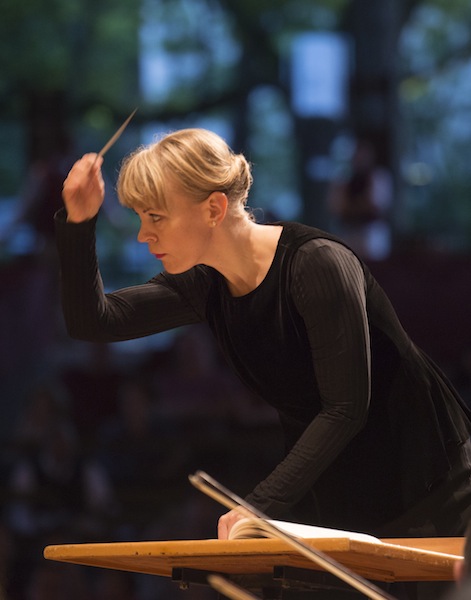Repin uneven in Sibelius, but Mälkki leads CSO in a notably fresh “Eroica” at Ravinia

Conductor Susanna Mälkki’s appearances with the Chicago Symphony Orchestra in recent years have received considerable kudos from critics and audiences alike, although the skimpy attendance for the first of her two appearances Thursday night at Ravinia suggests that she has yet to win over the North Shore faithful.
In a neat bit of programming symmetry and a nod to her Finnish roots, the orchestra has programmed music of Sibelius and Beethoven, with one concerto and one symphony by each on successive nights. Vadim Radim was the soloist in the Sibelius Violin Concerto Thursday, and Beethoven’s Symphony No. 3 (“Eroica”) filled out the program. The orchestra under Mälkki’s firm hand was in top form, even with many principals taking the night off.
Mälkki and Repin were a good musical match, their relatively straightforward viewpoints making for a nearly seamless partnership. Both are known for stripping decades of accumulated performance traditions from standard repertoire and looking at scores with fresh eyes. With a deservedly loyal fan base among violin connoisseurs, Repin has many memorable Chicago area appearances under his belt. Sadly, this performance found him considerably off his game.
Given Mälkki’s precise gestures and keen ear for textural details, it’s safe to assume the hushed orchestral tuttis at the opening and elsewhere in the first movement were lovingly rendered. Assume we must, since Ravinia’s full-throated cricket chorus utterly subsumed the orchestra’s quiet passages early in the concerto.
Repin attempted an understated opening, a sensible strategy given the flights of soaring lyricism and high-flying pyrotechnics that saturate much of the concerto. But his thin sound, shaky intonation, and patchy vibrato in these introductory bars foreshadowed problems to come, most notably in Sibelius’s many extended passages on the bottom G string of the violin.
Mälkki’s supportive accompanying gave the violinist room to explore every conceivable dynamic, but her vibrant tuttis were often more compelling than Repin’s solo flights. He seems to view the 1905 work as a lean 20th century masterpiece rather than a lush, 19th century romantic throwback. It’s a legitimate view, but one that failed to convince.
Repin was able to better connect with the score in some critical sections, in particular the extended first movement cadenza. He rightly presented it as vehicle for continued musical development rather than a platform for shallow showmanship. Intelligent details abounded, included some deftly voiced double stops and shrewdly molded dynamic gradations. But the fiendishly difficult final tutti was muddled, owing perhaps to a slight disagreement in tempo between soloist and conductor.
The middle movement fared somewhat better, with the soloist spinning soulful lyricism with graduated levels of intensity as a set-up for Sibelius’ ecstatic final climax. But one longed for the occasional indulgence or sense of spontaneity (genuine or otherwise) that characterize the most memorable readings.
By the finale, Repin seemed to have found his footing, and from time to time even allowed himself to inject personal touches that lent whimsy to a movement described by musicologist Donald Tovey as a “polonaise for polar bears.” Mälkki seemed comfortably in her element with the music of her compatriot, and no doubt her reading of Sibelius’s Second Symphony tonight will confirm her bona fides.
It is unreasonable and perhaps unwise to expect anything novel in a reading of Beethoven’s “Eroica” Symphony, but Mälkki’s take on the warhorse was consistently fresh and occasionally illuminating. Her tempos were on the fleet side of standard practice, but never ostentatiously so.
The first movement was the most conventional of the four, with only the slightest deviations of the primary tempo allowed for structural clarity. The second movement funeral march inspired more flexibility from her baton, as each new variation was announced with pullbacks that were smartly assorted based on relative harmonic tension and shifts in orchestration.
The scherzo was allowed to take flight of its own accord, and the CSO’s horn trio responded with rustic, full throated abandon. Most impressive was her account of the finale, a reading brimming with characterful contrast. Again tempos were on the quick side, but Beethoven’s startling mood swings were given a full, expansive platform. The wind principals were splendid throughout, most notably Keith Buncke (bassoon), John Bruce Yeh (clarinet), and Michael Henoch (oboe).
Susanna Mälkki conducts the Chicago Symphony Orchestra in Sibelius’s Symphony No. 2 and Beethoven’s Piano Concerto No. 3 with soloist Kirill Gerstein 8 p.m. Friday at Ravinia. ravinia.org
Posted in Performances

